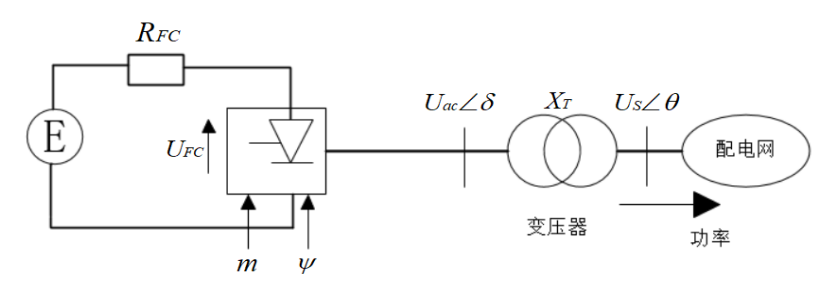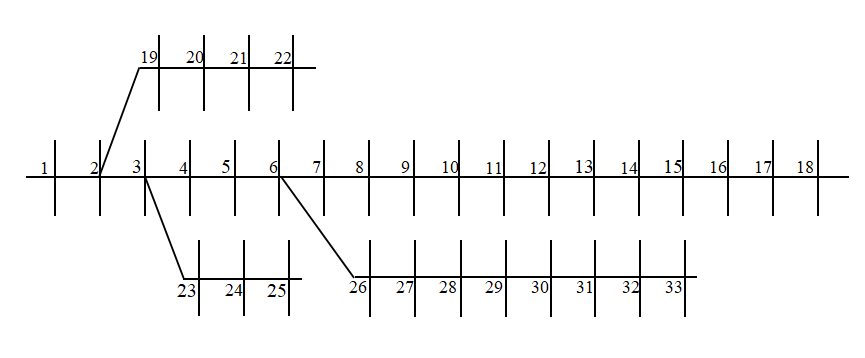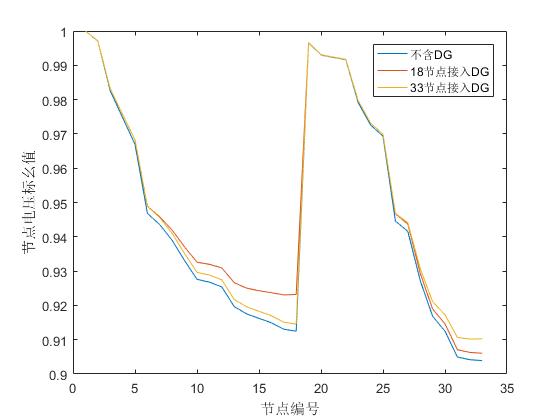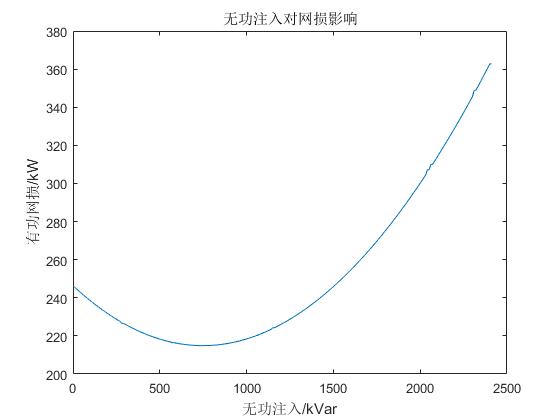主动配电网节能降损优化控制研究毕业论文
2020-07-11 18:02:58
摘 要
随着全球能源危机问题越来越严重,人们已经意识到了环境保护和资源有效利用的重要性。同样,在电力方面,人们也开始朝着利用可再生资源以及节能环保的方面进行研究。其中,分布式电源由于其清洁无污染的特点得到了人们越来越多的关注和研究。但大量分布式电源接入电力系统中会对配电网的有功功率损耗产生巨大影响,同时也会影响配电网的电能质量和供电可靠性。主动配电网的节能优化控制能够有效地降低配电网有功网损,同时也能提升配电系统地电能质量和安全性。因此,在资源逐渐匮乏地今天,研究主动配电网的节能降损控制有着非常重大的意义。
本文首先研究了包含多种分布式电源的潮流计算问题,分析了不同类型的分布式电源并建立他们的数学模型。将几种常见的分布式电源按照其工作原理分为 恒定,
恒定, 恒定,
恒定, 恒定以及
恒定以及 四种类型的节点。并根据电压、有功功率以及无功功率的关系将节点类型全都转化为
四种类型的节点。并根据电压、有功功率以及无功功率的关系将节点类型全都转化为 节点并代入前推回代潮流计算中。用MATLAB编写了潮流计算程序,为了对建立的前推回代算法模型进行验证,我们用它计算了接入分布式电源的IEEE33节点系统
节点并代入前推回代潮流计算中。用MATLAB编写了潮流计算程序,为了对建立的前推回代算法模型进行验证,我们用它计算了接入分布式电源的IEEE33节点系统
其次,本文建立了分布式电源优化配置模型,其目标函数为配电网系统的有功网损。该模型旨在寻找配电网中分布式电源接入的最优位置和容量,该模型能有效减少主动配电网中的有功网损同时也能提高配电网中的电压质量。之后本文介绍了智能算法中的粒子群算法,并用该算法求解了分布式电源的优化配置模型。
最后本文介绍了主动配电网的无功控制理论,即通过控制配电网中各无功量来达到降低有功网损和提升电能质量与供电可靠性的方法。并在分布式电源优化配置的基础上对配电网进行了节能降损的无功优化控制,优化结果表明在分布式电源优化配置之后,对配电网的无功优化控制仍能大幅度的降低配电网络的有功网损,同时可以使各节点电压保持在电压允许波动的范围内。
关键词:分布式电源 前推回代法 分布式电源优化配置 无功优化控制
Abstract
With the global energy crisis become more and more serious, people have realized the importance of environmental protection and effective utilization of resources. Meanwhile, in terms of electric power, people begin to study on the use of renewable resources, energy conservation and environmental protection. The distributed generation gets people more and more attention and research because of its clean and non-pollution. However, when a large number of distributed generation access the electric system, it will make a huge impact of the active power loss. At the same time it can affect the power quality and the reliability of power supply. The Energy-saving optimization control of active distribution networks can effectively reduce power loss and improve the power quality and safety. As a result, with the resources shortage, it has important significance in research the energy conservation and the loss reduction of active power control.
First, this paper studied the load flow calculation including a variety of distributed generation, and analyzed the different types of distributed generation to establish the mathematical models. According to the working principle several common distributed generation were divided into PQ constant, PV constant, PI constant, and PQ(V) constant. Then, according to the relationship between voltage, active power and reactive power, all of the nodes were converted to PQ nodes and substituted into the load flow calculation. We used MATLAB to code the flow calculation program. In order to verify the forward extrapolation algorithm model, we used it to calculate IEEE33 node system, which access the distributed power generation.
Second, this paper establishes a distributed power optimization configuration model whose objective function is the active network loss of the distribution network system. This model aims to find the optimal location and capacity of distributed power access in the distribution network. This model can effectively reduce the active network loss in the active distribution network and also improve the voltage quality in the distribution network. This paper introduces the particle swarm algorithm in the intelligent algorithm and uses it to solve the distributed power optimization configuration model.
Finally, this paper introduces the reactive power control theory of active distribution network, that is, the method of reducing active power loss and improving power quality and power supply reliability by controlling the reactive power in distribution network. Based on the optimized configuration of distributed power supply, the reactive power optimization control of power distribution network is performed. The optimization results show that after the optimal configuration of distributed power supply, the active network loss of the distribution network is reduced and the reactive power optimization control of distribution network can still be greatly improved. At the same time it can keep the voltage of each node within the allowable voltage fluctuation range.
Key words: distributed power supply;forward-back substitution;distributed power optimization configuration;reactive power optimization control
目录
第一章 绪论 1
1.1课题研究的背景及意义 1
1.2国内外研究现状 2
1.2.1 DG并网后配电网的潮流计算 2
1.2.2主动配电网关键技术 3
1.3本文主要研究内容 6
第二章 含分布式电源的潮流计算 8
2.1分布式电源概述 8
2.2分布式电源在潮流计算中的模型 8
2.2.1风力发电的数学模型 8
2.2.2太阳能光伏发电系统数学模型 10
2.2.3燃料电池的数学模型 11
2.2.4微型燃气轮机的数学模型 12
2.3分布式电源并网对配电网的影响 13
2.4含分布式电源的配电网潮流计算 14
2.4.1配电网潮流计算方法概述 14
2.4.2配电网前推回代潮流计算 16
2.4.3含分布式电源的配电网潮流计算 19
2.5分布式电源接入系统后网损影响的仿真算例 22
2.5.1含一个 类型的分布式电源的配电网潮流计算 24
类型的分布式电源的配电网潮流计算 24
2.5.2含多种分布式电源的配电网潮流计算 27
2.6本章小结 28
第三章 分布式电源优化配置 29
3.1分布式电源优化配置数学模型 29
3.1.1目标函数 29
3.1.2约束条件 30
3.2粒子群算法基本原理 31
3.3基于粒子群算法的分布式电源优化配置 33
3.3.1编码方案 33
3.3.2算法流程 34
3.4算例分析 35
3.5本章小结 36
第四章 主动配电网优化控制 37
4.1配电网无功优化理论 38
4.1.1无功补偿装置 38
4.1.2无功负荷及无功功率损耗 39
4.1.3无功功率对电压影响 40
4.1.4配电网的无功优化 41
4.2无功网损优化与电压控制 42
4.2.1电压控制 42
4.2.2网损调控 43
4.3主动配电网优化控制算例 44
4.4本章小结 45
总结 46
参考文献 47
致谢 52
附录 53
第一章 绪论
1.1课题研究的背景及意义
我们都知道电力系统中包含着输电和用电部分,而输电则主要靠配电网来实现。配电网处于电力系统的末端,其主要作用就是将主电网与用户连接并将电能从从发电厂传输到各个用电负荷处,同时也担负着分配电能的任务,是电力系统的核心部分。因此有效地优化控制配电网能够保证电力系统供电的可靠性、确保用户使用高质量的电能。随着经济的快速腾飞和科技的不断提高,越来越多的电力产品进入人们的生活中,人们对于电能的依赖程度越来越大,所以配电网的作用也变得尤为重要。
随着世界能源危机问题的不断加重和社会用电量的不断增大,解决电力传输中电能消耗过大的问题已经迫在眉睫,传统配电网的缺点在当下形势下暴露无遗。所以需要研究更加灵活、高效、智能以及可持续的配电网系统,这种智能的配电网系统需要分布式电源的接入和应用。分布式能源(DER)涵盖了多个主要部分,其中包括分布式发电(DG),可控负荷和分布式储能等。分布式发电主要指利用可再生能源进行发电的系统,例如光伏发电,风力发电,潮汐发电等。他是一种分散的发电方式,即接入的位置并不是在变压器端,而是可以从配电系统的任意节点接入。当分布式电源接入配电网络,会使配电网的运行更加经济,环保;同时也可以提高配电系统的传输电能质量,对配电传输有着非常积极的作用。但相应的,分布式电源的接入也会对配电网系统带来一系列的挑战,例如会增加配电网规划、运营、控制等方面的复杂程度。因此就需要一种优化控制方式来解决分布式电源接入配电网带来的问题,这里我们介绍一种使电力系统稳定运行的控制方式:无功电压控制。但是无功电压控制在对含有分布式电源的配电网进行优化时存在着一些问题需要我们研究解决。例如在传统配电网中无功电压控制只考虑了单项潮流,无法直接用于电网结构复杂,可能存在双向潮流的含DG的配电网。并且由于分布式电源的分散性、间歇性和不确定性,配电系统可能存在着较大的电压波动和复杂的无功电压分布。这都会对无功电压控制带来挑战
相关图片展示:











